Pembrokeshire is part of the United Kindom and uses the same currency (GBP) as
the rest of England and Wales. The currency units are the British Pound (£) and
the Penny (p) Some Welsh speaking outlets use (c) or (¢) instead of p.
It is also common practice to omit the p from all prices over £1.
You may also encounter stores which ignore both the £ and the p symbols e.g. 14.99 used instead of £14.99p
One penny (1p) is worth £0.01
One pound (£1) is worth 100p
Many stores now prefer bank card purchases (especially contactless) to cash.
One penny (1p) is worth £0.01
One pound (£1) is worth 100p
Many stores now prefer bank card purchases (especially contactless) to cash.
UK Bank Notes
We have recently replaced all our old paper banknotes with new polymer bank notes. The old paper notes are no longer legal tender. If caught with an old note, you MAY be able to get it changed
at a bank or post-office.
The design of new UK bank notes and coins is being updated to show our new monarch, King Charles III. The new notes/coins will be introduced gradually and circulate alongside the existing Queen Elizabeth II currency.
Purchasing low value goods with high value (especially £50) notes can cause problems for small traders and may even appear suspicious.
The design of new UK bank notes and coins is being updated to show our new monarch, King Charles III. The new notes/coins will be introduced gradually and circulate alongside the existing Queen Elizabeth II currency.
Purchasing low value goods with high value (especially £50) notes can cause problems for small traders and may even appear suspicious.
 Queen Elizabeth II £5 Note |
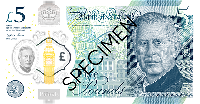 King Charles III £5 Note |
 Queen Elizabeth II £10 Note |
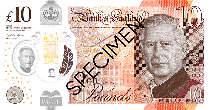 King Charles III £10 Note |
 Queen Elizabeth II £20 Note |
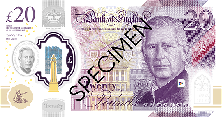 King Charles III £20 Note |
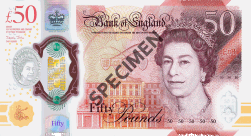 Queen Elizabeth II £50 Note |
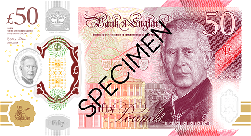 King Charles III £50 Note |
| Bank Note Images © Bank Of England | |
Scotland and Northern Ireland are allowed to issue their own Bank Notes but whilst they are "Legal",
they are not "Legal Tender" in Wales. To explain that comment, visitors, residents and shops can choose
to accept these bank notes (because they are legal) but they are often refused because they are not
a Welsh/English currency. (It is extremely rare to encounter either Scottish or Northern Irish notes in
Pembrokeshire!)
UK Coins
On one side of out coins, known as the "Heads", you will always find an image of our current monarch. Most of the coins in circulation feature our former Queen, Elizabeth II, however,
recently minted coins display our new King, Charles III. The old Queen Elizabeth II coins will remain in use for some time.
The design on the rear of the coins varies by coin value and year of manufacture. It is even possible to see different designs on two coins with identical value and minted in the same year.

Coin images courtesy of The Royal Mint
Images of the Queen Elizabeth II and King Charles III versions of current UK coinage
The design on the rear of the coins varies by coin value and year of manufacture. It is even possible to see different designs on two coins with identical value and minted in the same year.

Coin images courtesy of The Royal Mint
Images of the Queen Elizabeth II and King Charles III versions of current UK coinage
| Coin | Comment |
| 1p | Copper coloured approx. 20mm |
| 2p | Copper coloured approx. 26mm |
| 5p | Silver coloured approx. 18mm |
| 10p | Silver coloured approx. 24mm |
| 20p | Silver coloured approx. 21mm coin has 7 edges |
| 50p | Silver coloured approx. 23.4mm coin has 7 edges |
| £1 | Brass coloured outside Silver coloured inside approx 22mm coin has 12 edges |
| £2 | Brass coloured outside Silver coloured inside approx. 28mm |
 |
In 2017, an old version of the £1 coin was replaced with the new design. Although these coins are no longer legal tender, they are sometimes found in supermarket trolley locks. |
Most banks, larger post offices and some travel agents provide a currency exchange service but you may be asked for proof of identity.
Exchanges may advertise a 0% commission but it is still worth shopping around because the exchange rates vary.
Postage Stamps

Examples of UK Stamps
- Almost all "letter" postal services in the UK are operated by "Royal Mail" There are several companies (including Royal Mail,) offering parcel delivery services
- The price of postage varies according to envelope size (or parcel size,) weight, speed-of-delivery (1st / 2nd class etc.), additional services and destination country. Price guidance is available from Post Offices and RoyalMail.com
- Royal Mail stamps often come with Bar-Codes (they look like elongated QR codes.) The bar-code should be regarded as part of the stamp. Attach the combination of barcode and stamp to the top-right corner of your envelope
- Although it is unusual for UK postage stamps to identify their Country of Origin (UK,) they usually include a picture of our monarch - either as the main image or as a silhouette near the corner
- The price paid for a stamp is normally shown on the stamp. However, some stamps have special labels instead of prices - examples include
- 1ST - The most common "1st" stamp allows first-class postage of a small (envelope size/weight) letter within the UK
- 1ST Large - A variant of the 1st stamp, suitable for larger envelopes
- 2ND - The most common "2nd" stamp allows second-class postage of a small (envelope size/weight) letter within the UK
- 2ND Large - A variant of the 2nd stamp, suitable for larger envelopes
- You can attach more than one stamp, to pay for of postage within the UK (other countries receiving mail from the UK may apply their own rules.)
- You are not allowed to post certain items (e.g. explosives) and further restrictions/customs/taxes can affect international postage.
- All UK postal addresses should include a "Post Code"
- The post code contains letters A-Z and digits 0-9, it should contain 5, 6 or 7 characters
- The postcode uniquely identifies a small cluster of addresses, usually in one section of a road
- Postcodes are usually written as the last line of the address and may include a space immediately before the third-form-last character
- All postcodes in Milford Haven (UK) start with the charaters "SA73" - and the local post office uses the post code "SA73 2AA"
DigitalDan.co.uk
